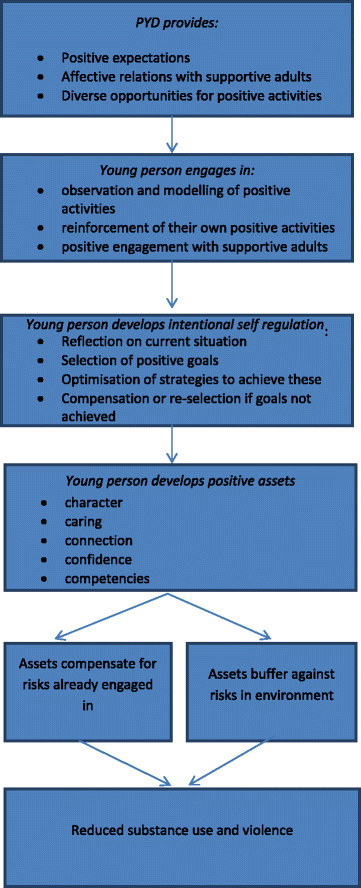What is positive youth development and how might it reduce substance use and violence? A systematic review and synthesis of theoretical literature
- PMID: 26864336
- PMCID: PMC4748512
- DOI: 10.1186/s12889-016-2817-3
What is positive youth development and how might it reduce substance use and violence? A systematic review and synthesis of theoretical literature
Abstract
Background: Preventing adolescent substance use and youth violence are public health priorities. Positive youth development interventions are widely deployed often with the aim of preventing both. However, the theorised mechanisms by which PYD is intended to reduce substance use and violence are not clear and existing evaluated interventions are under-theorised. Using innovative methods, we systematically searched for and synthesised published theoretical literature describing what is meant by positive youth development and how it might reduce substance use and violence, as part of a broader systematic review examining process and outcomes of PYD interventions.
Methods: We searched 19 electronic databases, review topic websites, and contacted experts between October 2013 and January 2014. We included studies written in English, published since 1985 that reported a theory of change for positive youth development focused on prevention of smoking, alcohol consumption, drug use or violence in out-of-school settings. Studies were independently coded and quality-assessed by two reviewers.
Results: We identified 16 studies that met our inclusion criteria. Our synthesis suggests that positive youth development aims to provide youth with affective relationships and diverse experiences which enable their development of intentional self-regulation and multiple positive assets. These in turn buffer against or compensate for involvement in substance use and violence. Existing literature is not clear on how intentional self-regulation is developed and which specific positive assets buffer against substance use or violence.
Conclusions: Our synthesis provides: an example of a rigorous systematic synthesis of theory literature innovatively applying methods of qualitative synthesis to theoretical literature; a clearer understanding of how PYD might reduce substance use and violence to inform future interventions and empirical evaluations.
Figures
Similar articles
-
Positive youth development programmes to reduce substance use in young people: Systematic review.Int J Drug Policy. 2016 Oct;36:95-103. doi: 10.1016/j.drugpo.2016.01.007. Epub 2016 Jan 19. Int J Drug Policy. 2016. PMID: 26874990
-
Incentives for preventing smoking in children and adolescents.Cochrane Database Syst Rev. 2017 Jun 6;6(6):CD008645. doi: 10.1002/14651858.CD008645.pub3. Cochrane Database Syst Rev. 2017. PMID: 28585288 Free PMC article.
-
Interventions for promoting habitual exercise in people living with and beyond cancer.Cochrane Database Syst Rev. 2018 Sep 19;9(9):CD010192. doi: 10.1002/14651858.CD010192.pub3. Cochrane Database Syst Rev. 2018. PMID: 30229557 Free PMC article.
-
How lived experiences of illness trajectories, burdens of treatment, and social inequalities shape service user and caregiver participation in health and social care: a theory-informed qualitative evidence synthesis.Health Soc Care Deliv Res. 2025 Jun;13(24):1-120. doi: 10.3310/HGTQ8159. Health Soc Care Deliv Res. 2025. PMID: 40548558
-
Incentives for preventing smoking in children and adolescents.Cochrane Database Syst Rev. 2012 Oct 17;10:CD008645. doi: 10.1002/14651858.CD008645.pub2. Cochrane Database Syst Rev. 2012. Update in: Cochrane Database Syst Rev. 2017 Jun 06;6:CD008645. doi: 10.1002/14651858.CD008645.pub3. PMID: 23076949 Updated.
Cited by
-
Effects of ACT Out! Social Issue Theater on Social-Emotional Competence and Bullying in Youth and Adolescents: Cluster Randomized Controlled Trial.JMIR Ment Health. 2021 Jan 6;8(1):e25860. doi: 10.2196/25860. JMIR Ment Health. 2021. PMID: 33338986 Free PMC article.
-
Dating Violence Victimization among Adolescents in Europe: Baseline Results from the Lights4Violence Project.Int J Environ Res Public Health. 2021 Feb 3;18(4):1414. doi: 10.3390/ijerph18041414. Int J Environ Res Public Health. 2021. PMID: 33546373 Free PMC article.
-
Children and adolescents' positive youth development qualities and internet addiction during the COVID-19 pandemic: A longitudinal study in China.Front Psychiatry. 2023 Jan 11;13:1068737. doi: 10.3389/fpsyt.2022.1068737. eCollection 2022. Front Psychiatry. 2023. PMID: 36713917 Free PMC article.
-
Train-the-Educator: Boosting Knowledge and Confidence for Conducting Substance Use Prevention Education.J Sch Health. 2025 Jan;95(1):78-93. doi: 10.1111/josh.13534. Epub 2025 Jan 7. J Sch Health. 2025. PMID: 39777684
-
Intervention Fidelity and Facilitator Training.West J Nurs Res. 2018 Dec;40(12):1843-1860. doi: 10.1177/0193945917752092. Epub 2018 Jan 3. West J Nurs Res. 2018. PMID: 29298636 Free PMC article.
References
-
- DWP . Households Below Average Income: An Analysis Of The Income Distribution 1994/5-2010/11. London: Department for Work and Pensions; 2012.
Publication types
MeSH terms
Grants and funding
LinkOut - more resources
Full Text Sources
Other Literature Sources
Medical
Miscellaneous



